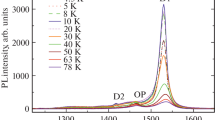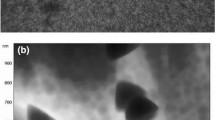Abstract
The data on a new phenomenon (a formation of the range of values for an electron-capture cross section) are reported by the example of an electron trap with a discrete level of E c -0.2 eV in γ-La2S3 crystals; the data were obtained by employing the thermally stimulated luminescence. The range of variations in the cross section is as large as four orders of magnitude (10−23–10−19 cm2). A model, according to which the electron trap at E c -0.2 eV is a donor involved in the donor-acceptor pairs distributed in interatomic distances and localized in the vicinity of a negatively charged dislocation, is suggested. It is shown that the formation of a range of electron-capture cross sections is a result of a spread of the cross-section modulation factor at points with different values of potential of the dislocation electric field.
Similar content being viewed by others
References
S. M. Ryvkin, Photoelectric Effects in Semiconductors (Fizmatgiz, Moscow, 1962; Consultants Bureau, New York, 1964).
M. A. Rizakhanov and F. S. Gabibov, Fiz. Tekh. Poluprovodn. (Leningrad) 13, 1324 (1979) [Sov. Phys. Semicond. 13, 776 (1979)].
M. A. Rizakhanov, Yu. N. Émirov, and N. A. Abilova, Fiz. Tekh. Poluprovodn. (Leningrad) 14, 1665 (1980) [Sov. Phys. Semicond. 14, 991 (1980)].
M. A. Rizakhanov and E. M. Zobov, Fiz. Tekh. Poluprovodn. (Leningrad) 14, 2407 (1980) [Sov. Phys. Semicond. 14, 1429 (1980)].
M. A. Rizakhanov, Fiz. Tekh. Poluprovodn. (Leningrad) 16, 699 (1982) [Sov. Phys. Semicond. 16, 448 (1982)].
M. A. Rizakhanov, Author’s Abstract of Doctoral Dissertation (Vilnius, 1982).
M. A. Rizakhanov and M. M. Khamidov, Pis’ma Zh. Tekh. Fiz. 11(9), 561 (1985) [Sov. Tech. Phys. Lett. 11, 234 (1985)].
E. M. Zobov, G. G. Garyagdyev, and M. A. Rizakhanov, Fiz. Tekh. Poluprovodn. (Leningrad) 21, 1637 (1987) [Sov. Phys. Semicond. 21, 991 (1987)].
F. S. Gabibov, E. M. Zobov, G. G. Garyagdyev, et al., in Photoelectronics (Vishcha Shkola, Kiev, 1987), No. 1, p. 54.
G. Ascarelli and S. Rodrigues, Phys. Rev. 124, 1321 (1961).
M. A. Rizakhanov and M. M. Khamidov, Fiz. Tekh. Poluprovodn. (St. Petersburg) 27, 721 (1993) [Semiconductors 27, 397 (1993)].
K. H. Nicholas and T. Woods, Br. J. Appl. Phys. 5, 783 (1964).
A. G. Zhdan, V. B. Sandomirskij, and A. D. Ozheredov, Solid-State Electron. 11, 783 (1968).
V. P. Mushinskii and V. P. Ambros, Izv. Vyssh. Uchebn. Zaved., Fiz., No. 4, 135 (1972).
V. M. Lupin and P. E. Ramazanov, Izv. Vyssh. Uchebn. Zaved., Fiz., No. 6, 142 (1976).
V. Ya. Kunin, A. N. Tsikin, and N. L. Shturbina, Fiz. Tverd. Tela (Leningrad) 15, 3417 (1973) [Sov. Phys. Solid State 15, 2276 (1973)].
A. N. Georgobiani, V. I. Demin, and E. S. Logozinskaya, Tr. Fiz. Inst. im. P.N. Lebedeva, Akad. Nauk SSSR 182, 69 (1987).
V. V. Antonov-Romanovskii, Izv. Akad. Nauk SSSR, Ser. Fiz. 10, 477 (1946).
G. F. T. Garlic and A. F. Gibson, Proc. Phys. Soc. London, Sect. A 60(342), 574 (1948).
M. A. Rizakhanov, Izv. Vyssh. Uchebn. Zaved., Fiz., No. 1, 153 (1971).
M. A. Rizakhanov, Electron-Oxygen Quasi-Particles in Proteins. Electronic-Atomic Theories of Elementary Photobiological Phenomena (Bari, Makhachkala, 1998).
Ch. B. Lushchik, Investigation of Trapping Centers in Alkali-Halide Phosphor Crystals (Tartu, 1955).
S. V. Bulyarskii and N. S. Grushko, Generation-Recombination Effects in Semiconductor Structures (Ul’yanovsk. Gos. Univ., Ul’yanovsk, 1997).
M. A. Rizakhanov, Fiz. Tverd. Tela (Leningrad) 31(11), 193 (1989) [Sov. Phys. Solid State 31, 1946 (1989)].
E. M. Zobov, V. V. Sokolov, A. Kh. Sharapudinova, and S. M. Luguev, Fiz. Tverd. Tela (St. Petersburg) 35, 636 (1993) [Semiconductors 35, 325 (1993)].
M. A. Rizakhanov, Fiz. Tekh. Poluprovodn. (Leningrad) 9, 2002 (1975) [Sov. Phys. Semicond. 9, 1310 (1975)].
Author information
Authors and Affiliations
Additional information
__________
Translated from Fizika i Tekhnika Poluprovodnikov, Vol. 35, No. 2, 2001, pp. 171–176.
Original Russian Text Copyright © 2001 by Zobov, Rizakhanov.
Rights and permissions
About this article
Cite this article
Zobov, E.M., Rizakhanov, M.A. The spread of cross section for electron capture by a trap with a discrete energy level in γ-La2S3 crystals. Semiconductors 35, 164–169 (2001). https://doi.org/10.1134/1.1349924
Received:
Accepted:
Issue Date:
DOI: https://doi.org/10.1134/1.1349924




